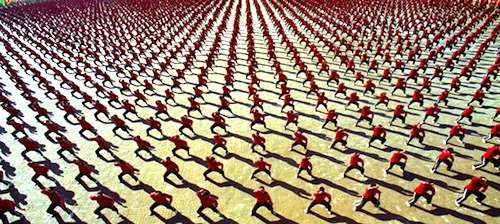By Joe Bendel. Shooting footage in twenty-five countries around the world, documentarian-visual essayists Ron Fricke and Mark Magidson must have met thousands of fascinating people. Yet, you will not meet any of them on a personal level in their latest 70mm spectacle. Their aesthetic favors the people en mass and dehumanized over messily unpredictable individuals. As their follow-up to 1992’s Baraka, director-cinematographer-co-writer-co-editor Fricke & producer-co-writer-co-editor-co-musical director Magidson’s Samsara takes viewers to some awe-inspiring sites all over the globe, intending it all to signify the great cosmic wheel of life, as the title translates from Sanskrit. Those who want to see it should see in a theater, the way it was meant to be seen, when Samsara opens today in New York.
Think of this as The Wall for politically correct Volvo-driving health nuts. Deeply steeped in Eastern religious traditions, Samsara captures some amazing images, such as the opening Balinese dancers, the archaeological wonderland of Petra, and the Tibetan Buddhist monks of Thikse creating impermanent sand mandalas. It would probably deepen any viewers’ appreciations to hear the dancers discuss their incredibly disciplined collective choreography, or to have the monks explain what the mandalas symbolize according to their faith, but Fricke and Magidson are not going there. There will be no talking and no text in the film.
Samsara brings to mind an old airline commercial from years ago, in which a charming old Southwestern artist tells viewers that the young painters who move to New Mexico and are blown away by the landscape are missing the point—it is the people who are really interesting. Fricke & Magidson are like those landscape painters, duly filming the sweeping awesomeness of nature. Yet, in a way, this makes things so much neater and tidier. When images of the disfigured are contrasted with scenes of armament factories, we cannot help but get the unsubtle message. Yet, the more we knew about individual cases might make it far harder to indulge in sweeping generalizations.

Some of the sequences in Samsara are absolutely arresting, like the shots of the Bagan temples in Burma, which did indeed grant the filmmakers access, after quite a bit of diplomatic and bureaucratic hoop-jumping. Sadly, when North Korea said “no,” Kim really meant “no,” so Fricke and Magidson were unable to film one of the giant choreographed stadium airangs. That’s too bad, because it would have fit right in with the rest of Samsara.
Without question, Samsara is lovely to look at (except when it is being deliberately ugly). There was obviously a conscious intent guiding the assemblage of the images, but they are still just images. Ultimately, the film is all surface and precious little substance. Any deeper meditations it might spur are solely due to viewer’s highly individualistic responses to the natural, sacred, and profane visuals it presents. Recommended just for those who enjoyed previous wide-screen picture books, like Baraka and Godfrey Reggio’s Koyaanisqatsi (on which Fricke served as cinematographer), Samsara opens today (8/24) in New York at the Landmark Sunshine.
LFM GRADE: B-/C+
Posted on August 24th, 2012 at 10:37am.